How to Make Potting Soil for Orchids (Step-by-Step Guide)
-
Melissa Gunter
- Last updated:

Orchids are easily one of the most beautiful plants around. They come from the Orchidaceae family and are known as the largest flowering plant on earth with over 30,000 different species. Orchids are also one of the oldest plants on earth having developed around 84 million years ago. This means they’ve had time to become set in their ways like one of your great-grandparents.
To keep an orchid happy and healthy, you can’t simply plant them in normal potting soil. No, they require a bit more finesse. Orchids aren’t like most plants. They don’t necessarily need soil to grow and be healthy. They need good airflow and great drainage. This is why making your own potting soil for orchids is one of the best ways to keep your plant thriving.
Let’s take a look at how you can make potting soil for orchids and provide you with a step-by-step guide for when it comes time to repot your orchids.
How to Tell if Your Orchid Needs Repotting
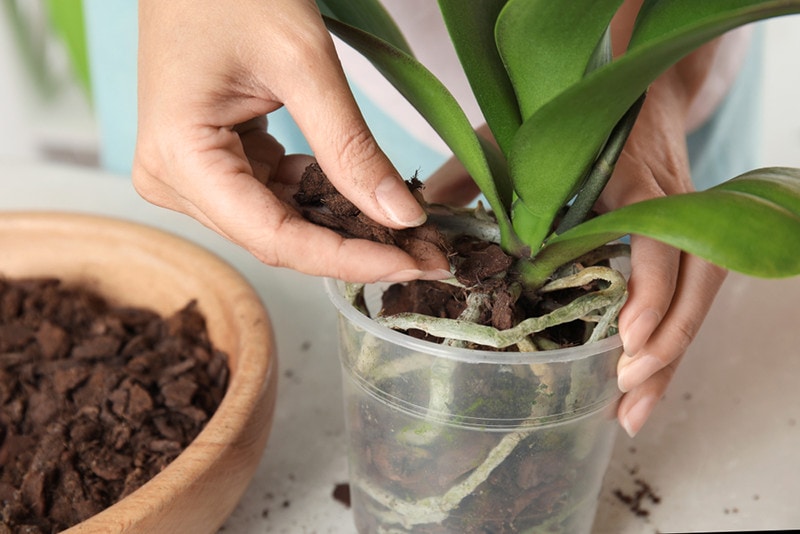
Normally, orchids are replanted in fresh pots and growing mediums every 1 to 2 years. People who buy a new orchid from the store often repot them as well in hopes of providing their plant with the pot it will call home for a time. Here are a few signs you should be aware of to indicate when it’s best to consider repotting your orchids. If any of these things happen, you will need a new container and a new potting medium.
- The potting media is decomposing or breaking down
- The orchid is getting too big for the container it’s currently in
- The roots of the plant are overgrowing
- The roots are diseased or dying
Potting Mediums
When caring for an orchid, potting mix isn’t what you need. Orchids require a potting medium to help increase the airflow and drainage the plants receive. One of the best potting mediums to use is bark mix. A bark mix works great for a variety of orchids out there and is one of the best ways to imitate an orchid’s natural growing environment. Let’s take a look at a few of the materials that can be used to make a great bark mix for your orchids.
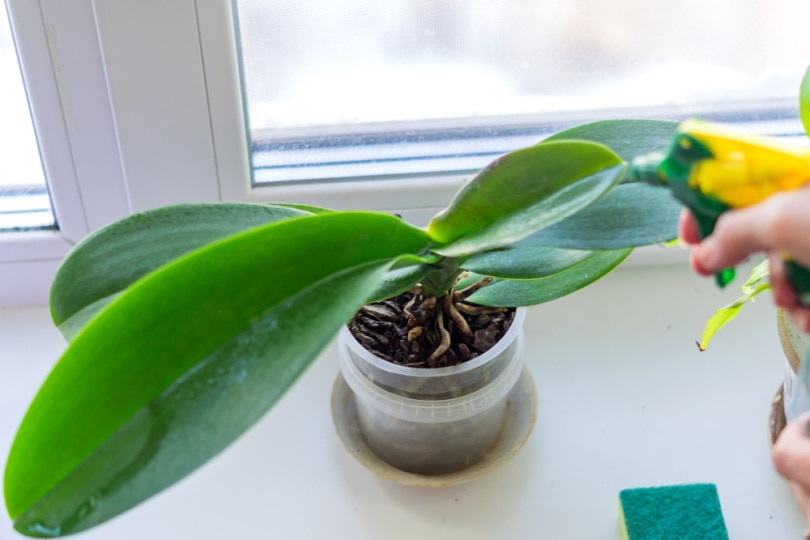
Fir Bark (Aerations)
Fir bark is available in grades that are fine, medium, and coarse. The fine fir bark is good at holding moisture and dries slowly. Course fir bark dries quickly due to it allowing in more airflow. This potting medium is popular due to it being easy to find and affordable. Unfortunately, it does resist water in the beginning and is known to decompose faster than the others we’ll look at.
Tree Fern (Aeration)
This planting medium is also available in grades. Tree Fern is slow to decompose but it does drain rather quickly. It is also an expensive medium to choose that struggles to retain water for your plant.
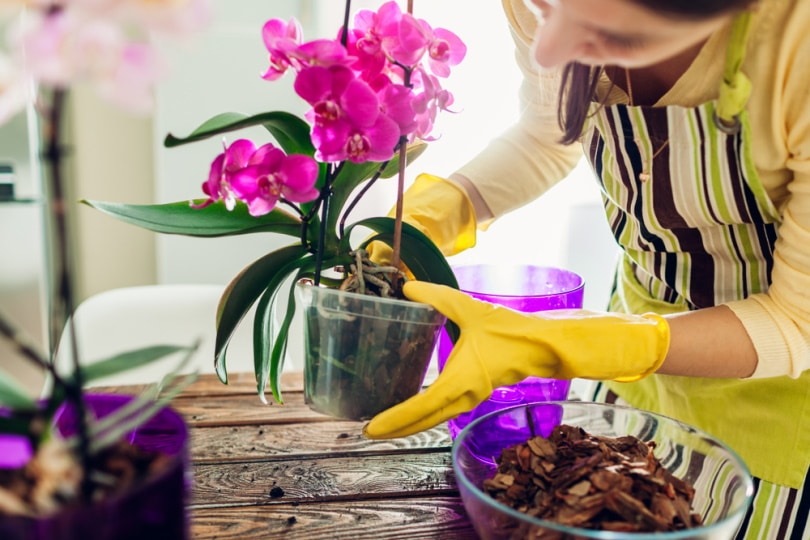
Sphagnum Moss (Water Retention)
Sphagnum moss or peat moss is great for terrestrial mixes. It’s readily available in most areas and is ideal for retaining water and air. When using this medium, however, you should pay close attention as it can begin to retain too much water if it’s packed too tightly or starts to decompose.
Perlite (Water Retention)
Yes, volcanic popcorn. Perlite is porous volcanic glass. This medium is ideal for storing moisture and nutrients thanks to it also draining excess moisture at the same time. This material is inexpensive, lightweight, and free from disease. It can’t be used alone, however, when making a potting mix for orchids as it may retain too much water for them to flourish.
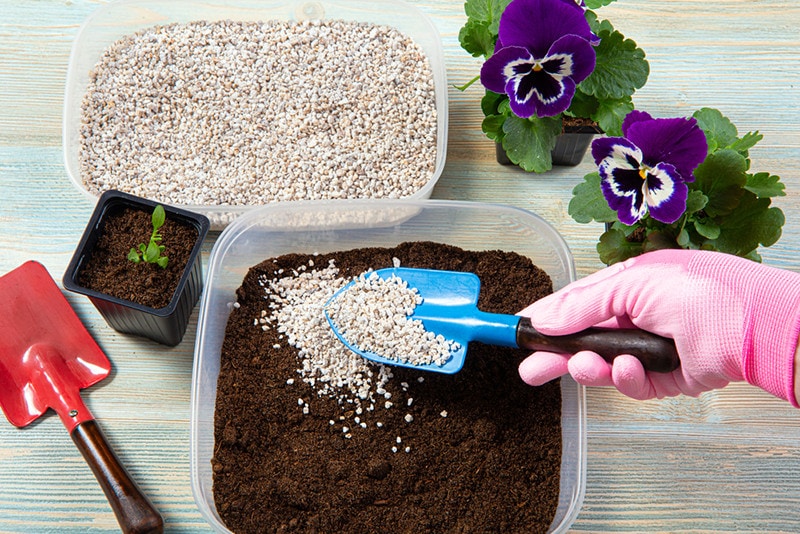
Coconut Husk Chips (Water Retention)
Coconut husk chips work great when added to your mixture due to them being quite absorbent. You’ll also find that these chips decompose at a slow rate. The chips don’t drain quite as well as coconut husk bark or chunks, however.
How to Make Potting Soil for Orchids
Now that you understand more about what goes into making a potting soil mix for an orchid, let’s take a look at the steps you should follow. This simple process should have you ready to repot your orchids in no time.
1. Choose a Workstation
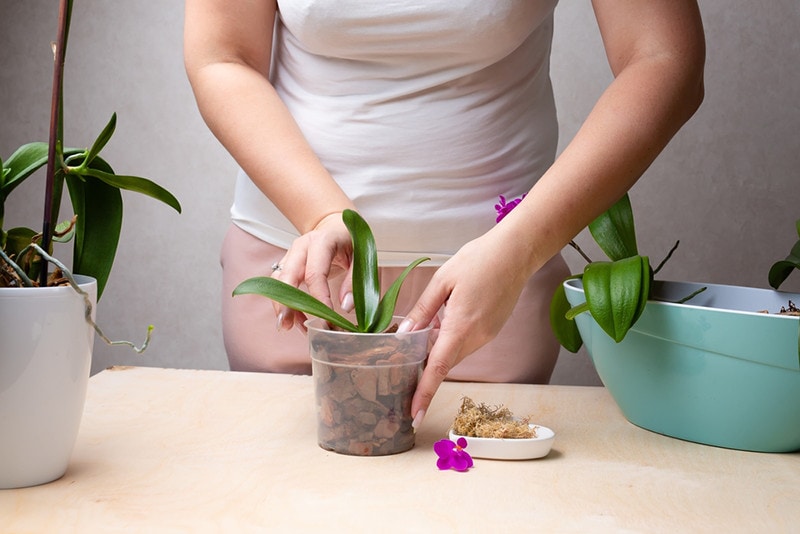
Before starting any DIY project you want a safe, clean space where you can work. When making potting soil for your orchids it is best to have a place where you can clean up easily. Your garage, greenhouse, or even the back porch are great ideas. If you do use your kitchen table, make sure to lay down newspaper or another covering to make cleaning up easier.
2. Choose Your Planting Mediums
You can’t start making your orchid potting mix without choosing which potting mediums we discussed above you’d rather use. Remember that the bark is used for airflow and the other potting mediums are used for moisture retention to keep your orchids healthy. This means you need both.
3. Gather All Your Materials
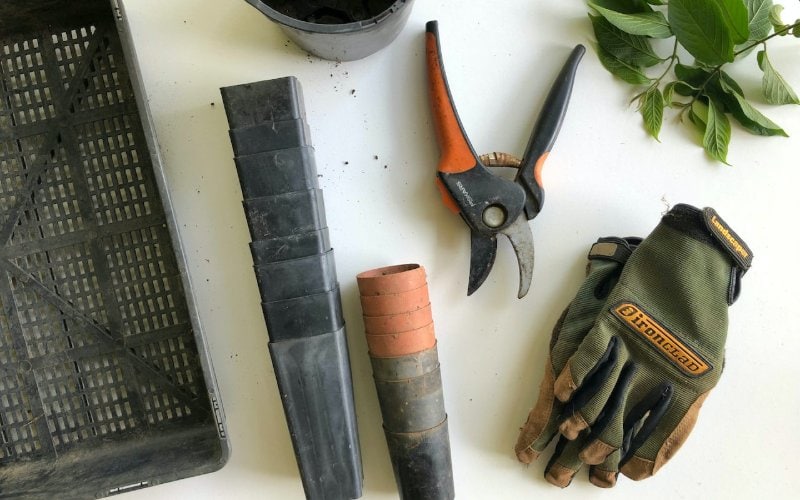
No project should be started without all the materials readily at hand. For making your orchid’s potting soil you’ll need the following tools and materials:
- Gloves
- Containers
- Your chosen bark or planting medium
- Your chosen secondary potting medium
4. Prepare the Primary Potting Mix
This is where you’ll prepare your chosen bark to provide your orchid with great aeration. Of the fir bark and tree fern options available, Douglas fir, ground coastal redwood bark, and Osmuna tree fern fiber are some of the most popular.
5. Prepare the Secondary Potting Medium

This is the step where you’ll get your moisture-retaining materials ready for use. The materials discussed above were peat moss, perlite, and coconut husk chips.
6. Mix the Ingredients
Now comes the time to mix both the primary and secondary potting mediums that you’ve chosen. When doing this, use the guiding ratio of 5:1 respectively. This should provide your orchids with both great airflow and proper water retention for healthy growth.
Conclusion
As you can see, caring for orchids takes more than just a green thumb. For those who want their orchids to thrive without having to seek out and purchase particular potting mixes, going the DIY route is your answer. This quick step-by-step guide can help make the process easier and leave your orchids looking beautiful.
Featured Image Credit: Raymond Vong Photography, Shutterstock
Contents
